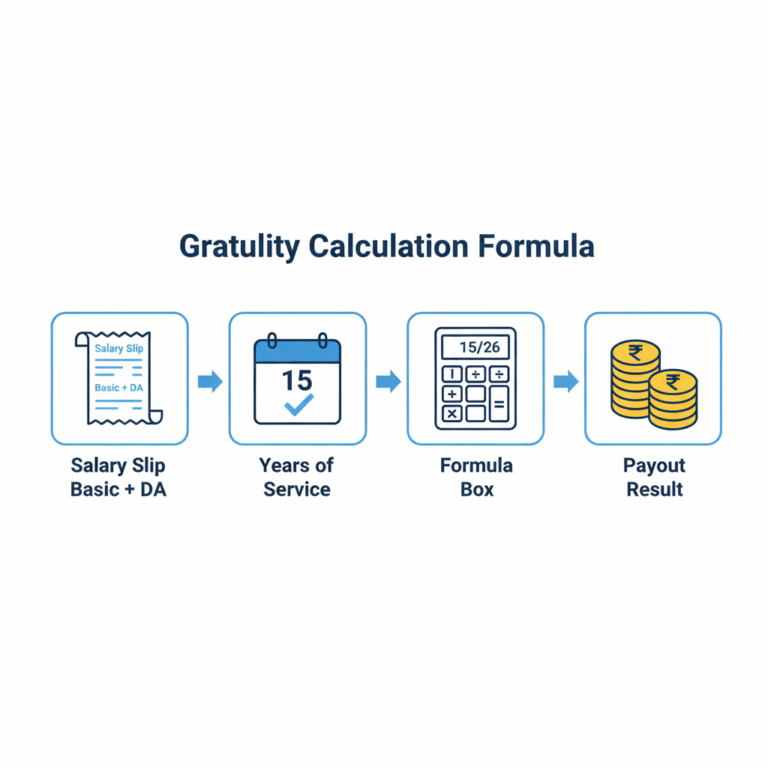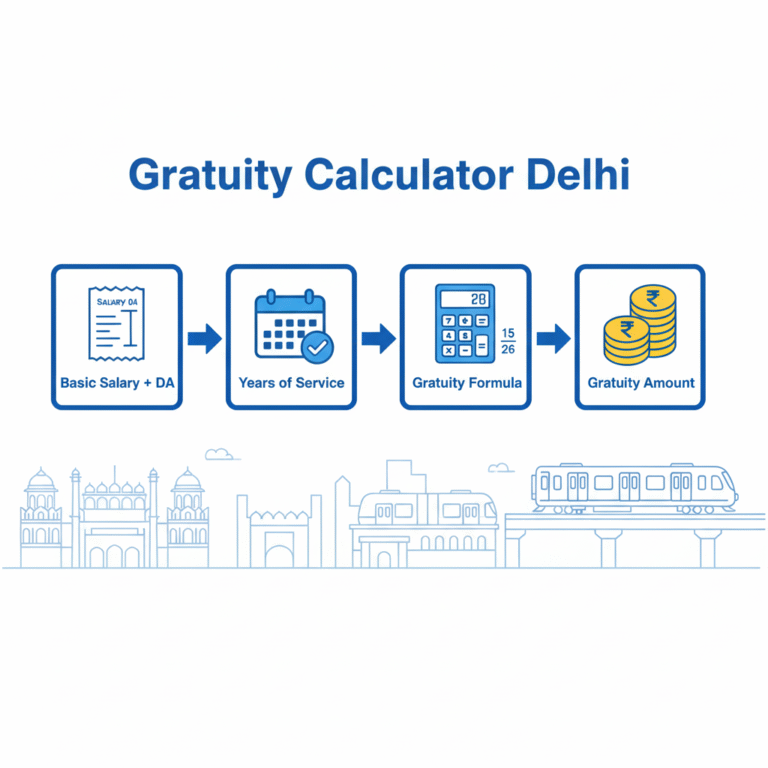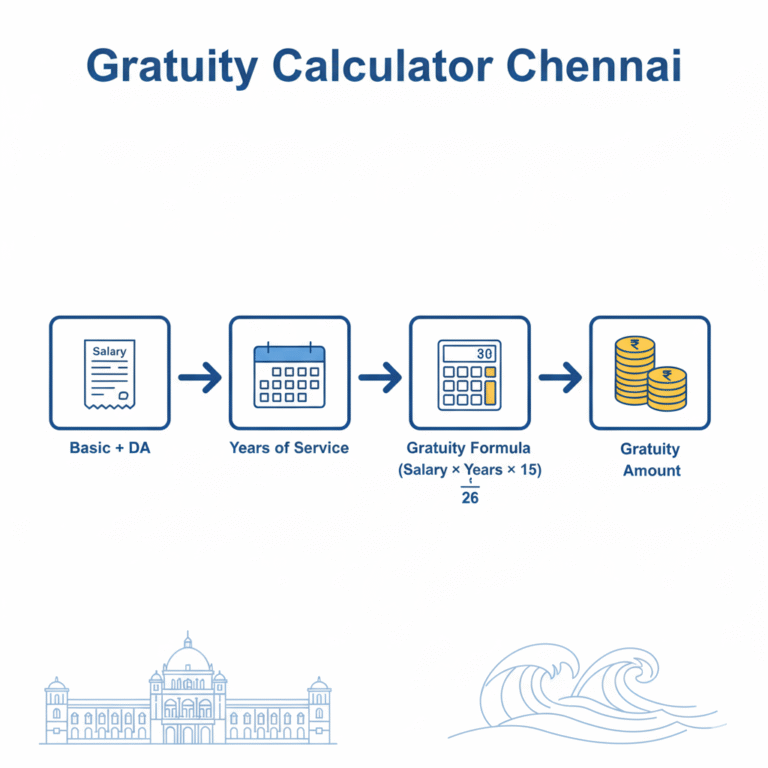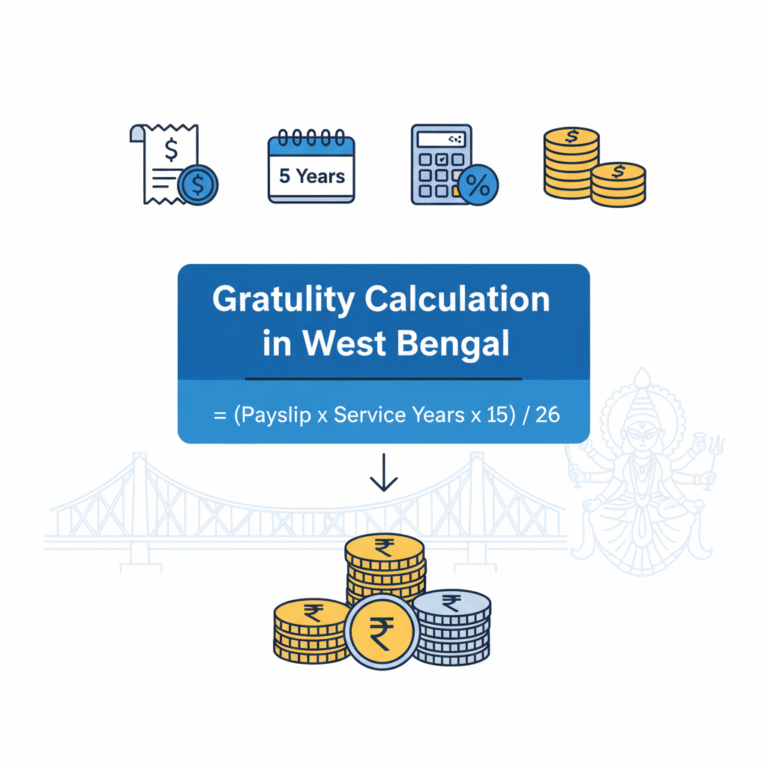What is Gratuity Calculation – Meaning, Rules & Formula
Meta description (SEO): Understand what is gratuity calculation, the exact formula used under the Payment of Gratuity Act, who is eligible, how to compute the amount step-by-step (with worked examples), tax treatment, employer obligations, and common pitfalls. Clear, practical and up-to-date guidance for employees and HR professionals.
Introduction — What is Gratuity Calculation matters
Gratuity is a statutory retirement benefit designed to reward long-term service. For many employees, the gratuity cheque is one of the largest lump sums received at the end of service and therefore understanding what is gratuity calculation is essential. This article walks you from the legal foundations to step-by-step calculations, edge cases (resignation, death, retrenchment), tax treatment, and practical tips — written to rank for search queries like how to calculate gratuity, gratuity formula, gratuity amount, and related search intent.
What is Gratuity Calculation? A plain-English definition
Gratuity is a one-time payment made by an employer to an employee when their employment ends (because of retirement, resignation subject to eligibility, death, or disablement). In India, the Payment of Gratuity Act, 1972, sets the minimum rules for who is entitled, how the payment is computed, and employer obligations. The Act applies to factories, establishments and shops meeting the employee count threshold and provides a standard method of calculation for most covered employees. Ministry of Labour & Employment
Legal framework and who it covers
The core law is the Payment of Gratuity Act, 1972 (and its Central Rules). The Act applies to establishments such as factories, mines, ports and to shops or establishments employing ten or more persons (central rules and state notifications set the administrative details). The Act establishes definitions (for example, “continuous service”), the controlling authority, nomination, and dispute resolution. Ministry of Labour & EmploymentHRY Labour
Important practical points:
- Most private-sector employees working for qualifying establishments are covered; independent contractors and apprentices are excluded in many cases.
- An employee is usually eligible only after completing a minimum period of continuous service (see next section). Ministry of Labour & Employment
Eligibility: Who qualifies for What is Gratuity Calculation?
Under the Act, gratuity is payable on termination of service after the employee has rendered continuous service for not less than five years. Exceptions apply: if termination happens because of death or disablement, the minimum service requirement is waived and gratuity is payable regardless of length of service. Continuous service has a legal definition that includes certain permitted breaks and rules for counting tenure. Ministry of Labour & Employment
The standard gratuity formula (what you searched for)
When people search “what is gratuity calculation” they’re usually looking for the precise formula. The statutory formula commonly applied under the Act is:
Gratuity = (Last drawn salary × 15 × Number of completed years of service) ÷ 26
Key points to interpret the formula:
- Last drawn salary normally means basic salary + dearness allowance (DA) — allowances that form part of basic pay for the purpose of this Act. Other allowances or bonuses are not normally part of the “last drawn salary” for statutory calculation unless specifically included by an employer’s policy or standing order. Ministry of Labour & EmploymentTATA AIG Insurance
- The factor 15/26 represents 15 days’ wages per completed year, where a month is considered as 26 working days for the purpose of this calculation (hence the ÷ 26).
- For establishments not covered under the Act but which still provide gratuity under an internal policy, employers sometimes use ½ month’s salary per year (equivalent to 15/30), so understanding whether your employer is covered by the Act is important. ICICI Directwww.bajajfinserv.in
Why 15/26? The logic behind the numbers
The Act specifies 15 days’ wages for each completed year of service. To convert “days’ wages” into a monthly wage basis the industry convention used in the statute is a month = 26 working days (excluding weekly holidays), which is why the formula uses 15/26. This standardizes the amount and avoids treating calendar months inconsistently. Ministry of Labour & Employment
Step-by-step What is Gratuity Calculation (worked example)
Scenario: Last drawn basic + DA = ₹48,000 per month; completed years of service = 12 years and 7 months. For statutory calculation we consider completed years and round if rules allow; here completed years = 12 (but if more than six months of final year the practice is to round up to 13 — see rounding rules below).
Step 1 — Establish last drawn salary (basic + DA): ₹48,000.
Step 2 — Decide completed years of service: If the employer follows the normal rounding rule where service exceeding six months in the final year is rounded up, 12 years 7 months might be treated as 13 completed years (employer practice and rules can vary; check the establishment’s policy). If not rounded, use 12.
Step 3 — Apply the formula:
If rounded to 13 years: Gratuity = (48,000 × 15 × 13) ÷ 26
Calculate numerator: 48,000 × 15 × 13 = 48,000 × 195 = 9,360,000
Divide by 26: 9,360,000 ÷ 26 = ₹360,000
So the gratuity payable would be ₹3,60,000 (subject to statutory ceiling and any internal policy enhancements).
If unrounded (12 years): Gratuity = (48,000 × 15 × 12) ÷ 26 = (48,000 × 180) ÷ 26 = 8,640,000 ÷ 26 = ₹332,307.69 → usually rounded to nearest rupee by the employer.
This step-by-step method applies for most covered establishments. Use exact salary figures (basic + DA) and precise completed year counts for accurate results. Ministry of Labour & Employment
Rounding rules and partial years
The Act counts completed years of service. Common practice and many employer policies round up the final year if the employee has served more than six months in that year — effectively treating 6+ months as a full year for gratuity rounding. This is a widely used convention but check your employer’s policy or the terms of employment for the exact approach applied. Groww
Gratuity ceiling and limits (taxable vs exempt amounts)
There is a statutory ceiling on the amount that is eligible for tax exemption under Income Tax provisions. For non-government employees, the commonly referenced ceiling for tax-free gratuity is ₹20,00,000 (₹20 lakh) — amounts above this are typically taxed unless other specific exemptions apply. The Payment of Gratuity Act itself was amended to increase the maximum limit of gratuity payable under the Act in past amendments and central government notifications; because legal ceilings occasionally change, employers and employees should verify the current maximum at the time of payment. ClearTaxPress Information Bureau
Important SEO note (keywords): People search for gratuity ceiling, gratuity tax exemption limit, and maximum gratuity amount — make sure to cross-check the latest government notification before using a hard number in payroll. ClearTax
Death, disablement & special cases
If an employee’s service terminates due to death or permanent disablement (resulting from an accident or disease), gratuity becomes payable irrespective of the five-year rule. The Act gives protection to the family/nominee: the amount payable is based on the same formula but the eligibility requirement of five years does not apply. In many cases the nominee must produce certain documents and make a claim in the prescribed form. Ministry of Labour & Employment
Employers’ obligations: timelines and interest for delay
Once gratuity becomes payable, the employer is required by law to determine the amount and notify the employee and the controlling authority. Generally, the employer must arrange payment within 30 days from the date it becomes payable. If the employer delays beyond the statutory period, they may be liable to pay interest on the delayed amount at a rate notified by the Central Government. The law also sets out procedures for disputes and deposits with the Controlling Authority if there is a disagreement. Chief Labour CommissionerMinistry of Labour & Employment
Tax treatment: What is Gratuity Calculation is tax-exempt?
Tax law treats gratuity differently for government employees, non-government (covered by the Act) employees, and other categories. Broadly:
- Government employees: Gratuity received on retirement is typically fully exempt from income tax.
- Non-government employees covered under the Act: Exemption is available up to the least of: (a) actual gratuity received, (b) the amount calculated by formula, or (c) the statutory ceiling for exemption (commonly ₹20 lakh as referenced in many tax guides).
- Employees not covered under the Act: Tax exemption is computed using a different formula prescribed by tax rules (subject to limits). ClearTaxTATA AIG Insurance
Because tax rules are updated regularly (annual budgets, tax notifications), verify current exemption ceilings with Income Tax Department guidance before filing returns. ClearTax
Gratuity vs leave encashment vs provident fund — what’s the difference?
These three are distinct post-service benefits:
- Gratuity: A statutory lump sum for long service (subject to the Act).
- Leave encashment: Payment for accumulated but untaken leave at termination — taxed differently and subject to separate income-tax rules.
- Provident Fund (PF): Employee & employer contributions in a retirement corpus (EPF), which grows over time and is subject to withdrawal rules.
All three may appear together in a retirement settlement, but each is calculated differently and has its own documentation and tax treatment. When preparing final settlement documents, confirm each component is separately described and taxed correctly. ClearTax
Gratuity for part-time, contract and seasonal workers
The Act contains special provisions for seasonal establishments and has rules about when an employer is covered. For seasonal employees, gratuity may be calculated on the basis of days or seasons (e.g., seven days’ wages for each season in some rules). For contractual workers, the determining factor is whether they are “employees” for the establishment under the Act; many organizations calculate gratuity for contractual employees if their contract equates to employment. Always refer to the establishment’s contracts, state rules and controlling authority guidance. Ministry of Labour & EmploymentDon Bosco Group of Schools
How disputes are resolved (controlling authority & appeals)
If there is a dispute about entitlement, amount, or the person entitled to gratuity, the employer or employee can approach the Controlling Authority (the district labour officer or the authority designated in the state) who will conduct an inquiry and determine the dispute. The Act provides a framework for deposits, interim payments and appeals to higher authorities if parties are dissatisfied with the decision. Employers often prefer to deposit amounts admitted to avoid penalties while disputes are resolved. Chief Labour Commissioner
Practical tips for employees and HR teams
For employees:
- Keep payslips showing basic + DA for the final months to verify the last drawn salary.
- Ensure your service dates are accurately recorded — small gaps, leaves, or unpaid breaks can affect the “continuous service” calculation.
- If you leave by resignation after five years, expect to apply in the prescribed form and follow up if payment is delayed beyond 30 days.
For HR/payroll:
- Maintain clear documentation: appointment letter, service records, salary structure showing basic & DA, nomination forms, and application/notice copies.
- If a dispute appears likely, use Form L/M notices and deposit admitted amounts with the controlling authority to prevent personal liability.
- Use an automated gratuity calculator in payroll but have a manual check for one-off cases (e.g., death or contractual employees). Ministry of Labour & EmploymentLabour Commissionerate
Common mistakes & how to avoid them
- Using gross salary instead of basic + DA: Many employers mistakenly include HRA, bonus or other allowances — statutory calculation typically uses basic + DA only. Always verify your employer’s policy and statutory interpretation. Ministry of Labour & Employment
- Rounding inconsistently: Apply a consistent rounding rule for the final year (document the policy).
- Missing nomination or documents at the time of death: Keep nomination details updated to prevent delays to nominees.
- Confusing gratuity with leave encashment: Treat them as separate payroll items for settlement and tax reporting.
Using a What is Gratuity Calculation: what to enter
Most online gratuity calculators ask for:
- Last drawn basic + DA (monthly)
- Date of joining and date of leaving (to compute completed years)
- Whether the establishment is covered under the Payment of Gratuity Act (to choose 15/26 vs 15/30)
Online tools are handy for estimates; always reconcile calculator results with payroll calculations based on the Act and employer policy. Popular payroll portals and banks offer gratuity calculators for quick checks. ClearTaxICICI Direct
Example scenarios (quick reference)
Example A — Retirement after 20 years:
Last drawn basic + DA = ₹60,000; completed years = 20.
Gratuity = (60,000 × 15 × 20) ÷ 26 = (18,000,000) ÷ 26 = ₹692,307.69 → typically rounded by employer.
Example B — Death after 2 years (not completed 5):
Last drawn salary = ₹30,000. Because gratuity is payable on death irrespective of minimum years, gratuity = (30,000 × 15 × 2) ÷ 26 = (900,000) ÷ 26 = ₹34,615.38 (subject to rounding and nomination procedures).
Example C — Non-covered establishment using half-month rule:
If employer policy says ½ month per year, use (Last drawn salary × 0.5 × years) e.g., ₹40,000 × 0.5 × 8 = ₹160,000.
Note: Always validate with controlling authority rules if in doubt. Ministry of Labour & Employmentwww.bajajfinserv.in
How to claim gratuity — forms & process
The Rules prescribe specific application forms for employees, nominees or legal heirs. The usual steps:
- Submit the prescribed form (or plain paper application where allowed) to the employer with supporting documents.
- Employer verifies and issues a notice (Form L) specifying the amount and sets a date for payment within 30 days.
- If employer refuses or disputes arise, the claimant can approach the Controlling Authority for adjudication. Employers should deposit admitted amounts with the Controlling Authority where disputes exist. Ministry of Labour & EmploymentLabour Commissionerate
SEO oriented content pointers (for website owners / content editors)
If you’re creating a page around the keyword “what is gratuity calculation”:
- Use the exact keyword in the H1, in the first 100 words, and in at least one subheading.
- Include long-tail variations and LSI words across the article: how to calculate gratuity, gratuity formula explained, gratuity calculator, gratuity tax exemption, gratuity eligibility, Payment of Gratuity Act.
- Offer a clear worked example with numbers (people search for examples).
- Provide downloadable/printable FAQ and a simple calculator widget to increase dwell time and satisfy transactional intent.
- Keep content updated annually and add a date stamp because statutory limits and tax rules change — link to authoritative sources (Ministry of Labour, Income Tax Department). Ministry of Labour & EmploymentClearTax
Recent amendments & why checking current law matters
Labour laws and tax thresholds are occasionally updated by Parliament and Central Government notifications (for instance, the Act’s maximum admissible gratuity has been amended in the past). Because ceilings and procedural rules can change, always confirm the latest rule or notification before quoting a definitive ceiling amount on payroll or tax filings. Online payroll sites and official government portals publish updates to help HR teams comply. Press Information BureauClearTax
Quick reference checklist for HR before final settlement
- Confirm final basic + DA as per salary structure.
- Verify dates of joining and leaving; determine completed years and rounding.
- Check if the establishment is covered under the Payment of Gratuity Act.
- Ensure nomination forms are on record.
- Issue Form L (or equivalent notice), set payment date within 30 days.
- Compute tax exemption and prepare Form 16/annexures if required.
- Keep records of payment, calculations and correspondence for audit.
Conclusion — crisp summary of “what is gratuity calculation”
What is gratuity calculation? It is the process of computing the statutory lump sum payable to a departing employee under the Payment of Gratuity Act, primarily using the formula (Last drawn salary × 15 × completed years of service) ÷ 26, with last drawn salary generally meaning basic + dearness allowance. Eligibility commonly requires five years of continuous service (exceptions for death/disablement), payment must be arranged within 30 days of it becoming payable, and tax exemptions have statutory ceilings that should be checked for the current year. For accuracy and compliance, always validate your numbers against your employer’s policy and the latest government notifications. Ministry of Labour & EmploymentChief Labour CommissionerClearTax







